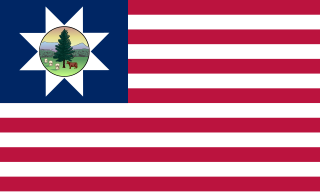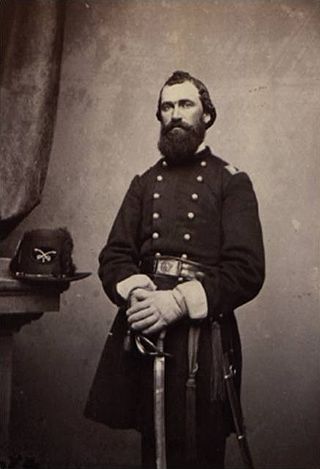
The Second Battle of Bull Run or Battle of Second Manassas was fought August 28–30, 1862, in Prince William County, Virginia, as part of the American Civil War. It was the culmination of the Northern Virginia Campaign waged by Confederate Gen. Robert E. Lee's Army of Northern Virginia against Union Maj. Gen. John Pope's Army of Virginia, and a battle of much larger scale and numbers than the First Battle of Bull Run fought on July 21, 1861, on the same ground.

The Battle of Blackburn's Ford took place on July 18, 1861, in the Confederate state of Virginia, as part of the Manassas campaign of the American Civil War. Union general Irvin McDowell's Army of Northeastern Virginia was marching south towards the Confederate capital of Richmond, and encountered the Confederate Army of the Potomac under the command of P. G. T. Beauregard. McDowell sent troops from Daniel Tyler's division to probe the Confederate defenses along Bull Run Creek to locate the Confederate left flank. At Blackburn's Ford, the Union troops attempted to cross but Confederate fire broke up the attack. The repulse at Blackburn's Ford led McDowell to seek to attack the Confederates at a different point along their line, leading to the First Battle of Bull Run three days later.

The Manassas Station Operations included the operations known as Bristoe Station, Kettle Run, Bull Run Bridge, or Union Mills. It took place August 25–27, 1862, in Prince William County, Virginia, as part of the Northern Virginia Campaign of the American Civil War.
Loudoun County, Virginia, was destined to be an area of significant military activity during the American Civil War. Located on Virginia's northern frontier, the Potomac River, Loudoun County became a borderland after Virginia's secession from the Union in early 1861. Loudoun County's numerous Potomac bridges, ferries and fords made it an ideal location for the Union and Confederate armies to cross into and out of Virginia. Likewise, the county's several gaps in the Blue Ridge Mountains that connected the Piedmont to the Shenandoah Valley and Winchester were of considerable strategic importance. The opposing armies would traverse the county several times throughout the war leading to several small battles, most notably the Battle of Ball's Bluff.

The 2nd Vermont Brigade was an infantry brigade in the Union Army of the Potomac during the American Civil War.

The 1st West Virginia Cavalry Regiment served in the Union Army during the American Civil War. Although it started slowly, it became one of the most active and effective of the West Virginia Civil War regiments—and had 14 Medal of Honor recipients, the most for any West Virginia regiment during the war. It was originally called the 1st Virginia Cavalry, not to be confused with the Confederate 1st Virginia Cavalry. Some reports added "Union," "Loyal" or "West" when identifying this regiment. After the Unionist state of West Virginia was officially admitted to the Union in 1863, the regiment became the 1st West Virginia Cavalry Regiment. The National Park Service identifies it as the 1st Regiment, West Virginia Cavalry.

The 53rd Pennsylvania Volunteer Infantry was a volunteer infantry regiment in the Union Army during the American Civil War.

Ariovistus Pardee Jr. was an officer in the Union Army during the American Civil War. He rose to fame during the Battle of Gettysburg, where he led the defense of a portion of Culp's Hill on July 3, 1863. A monument on the Gettysburg Battlefield commemorates the spot as "Pardee Field."
The 87th Pennsylvania Volunteer Infantry was an infantry regiment that served in the Union Army during the American Civil War.

1st Maryland Cavalry Battalion, Potomac Home Brigade, originally organized as the 1st Potomac Home Brigade Cavalry, "Cole's Cavalry" was formed under the guidance of Henry A. Cole. There are also references to it being designated as Cole's 1st Volunteer Maryland Cavalry. The unit, a battalion, originally consisted of four companies, A, B, C & D and was initially enlisted between August 10 and November 27, 1861.

Jacob C. Higgins (1826–1893) was a commander of Pennsylvania troops who participated in both major military conflicts of his time, the Mexican–American War and the American Civil War. Among his Civil War commands, he guided the 125th Pennsylvania Infantry regiment under heavy fire during the Battle of Antietam and likewise during the Battle of Chancellorsville. Following the muster out and return home of the 125th PA, the Gettysburg Campaign sent cavalry under Confederate General John D. Imboden to threaten vital railroad resources at Altoona and iron production facilities in the Juniata River watershed; in response, Emergency Militia was organized by Colonel Higgins and minimized this northwestern incursion.

The Battle of Fairfax Court House was fought during the Gettysburg Campaign of the American Civil War between two cavalry detachments from the Union Army of the Potomac, commanded by General Joseph Hooker, and the Confederate Army of Northern Virginia, commanded by General Robert E. Lee.

The 148th Regiment Pennsylvania Volunteer Infantry was an infantry regiment that served in the Union Army during the American Civil War.

The 28th Pennsylvania Volunteer Infantry was an infantry regiment that served in the Union Army during the American Civil War. It was noted for its holding the high ground at the center of the line at Antietam as part of Tyndale's 1st Brigade, Greene's 2nd Division of Mansfield's XII Corps.
The 2nd Pennsylvania Infantry Regiment was a Union army regiment that participated in the early part the American Civil War.

The 213th Regiment Pennsylvania Volunteer Infantry, alternately the 7th Union League Regiment was an infantry regiment of the Union Army in the American Civil War. It was raised in Philadelphia close to the end of the war, and spent its nine months of service on guard duty at Camp Parole and Washington, D.C.

The 211th Regiment Pennsylvania Volunteer Infantry was an infantry regiment of the Union Army in the American Civil War. Raised in western Pennsylvania in September 1864, the regiment initially served with the Army of the James during the Siege of Petersburg, holding trenches at Bermuda Hundred. In late November it transferred to the Army of the Potomac and during the northern hemisphere spring campaign fought in the counterattack during the Battle of Fort Stedman and the Union breakthrough at Petersburg. During the last days of the Appomattox Campaign it guarded trains, and participated in the Grand Review of the Armies following the end of the war before mustering out.

The 201st Regiment Pennsylvania Volunteer Infantry was an infantry regiment of the Union Army in the American Civil War. Raised in the Harrisburg, Pennsylvania area during August 1864, the regiment initially guarded the Manassas Gap Railroad and detachment elements on provost duty in Virginia. The regiment then moved to Alexandria in November, where it performed guard and escort duty. After the end of the war the main body of the regiment garrisoned Fort Delaware before mustering out in mid-1865.

The 207th Regiment Pennsylvania Volunteer Infantry was an infantry regiment of the Union Army in the American Civil War. Raised mostly in northern and central Pennsylvania in mid-1864, the regiment initially served with the Army of the James during the Siege of Petersburg, holding trenches at Bermuda Hundred. In late November it transferred to the Army of the Potomac and during the northern hemisphere spring campaign fought in the counterattack during the Battle of Fort Stedman and the Union breakthrough at Petersburg. During last days of the Appomattox Campaign it guarded the supply line, and participated in the Grand Review of the Armies following the end of the war before mustering out.

The Warrenton Junction Raid was a surprise attack by Confederate guerrilla warriors on a Union cavalry detachment during the American Civil War. The raid took place near a railroad junction in Virginia's Fauquier County, less than 10 miles (16 km) from the town of Warrenton. Confederate Major John S. Mosby led the attack against about 100 men from the Union's 1st (West) Virginia Cavalry. At first, the raid was very successful, as many of the Union soldiers surrendered to the rebels. The remaining portion of the surprised force was surrounded in a house, and two of their leaders were wounded. The house was set on fire, and the Union soldiers surrendered. As Mosby's men rounded up prisoners and horses, a detachment of the 5th New York Cavalry surprised the rebels and rescued most of the captured Union soldiers. After a short fight, more men from the 5th New York, and the 1st Vermont Cavalry, joined in the pursuit of Mosby's fleeing rebels.
















